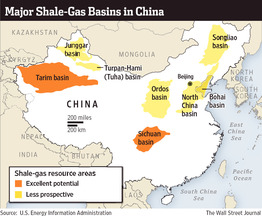As China’s economy continues to grow, so does its energy needs. China remains the world’s leading consumer, producer, and importer of coal. However, as Burke Ugarte blogged about in his post concerning, China has been investing in infrastructure to support other forms of energy (e.g. oil and gas pipelines). In the wake of the US shale revolution, China’s upstream players have begun exploring the potential for a similar shale revolution. Although China has the world’s biggest technically recoverable shale reservoir, tapping these reservoirs is economically infeasible for China’s state owned E&P companies.
China’s shale gas fields occur in areas of the country with limited access to water. Water is a necessity in the drilling process as the primary constituent of drilling fluid. Much of northern and western China is plagued by lack of rainfall, and these areas coincidentally the same areas under which prolific shale deposits lie. Further, China has yet to develop the horizontal drilling and hydraulic fracturing techniques necessary to access these fields. Oil field service companies (e.g. Halliburton and Schlumberger) have little incentive to invest in China, especially with the current low price of hydrocarbons. It seems that until technological innovation allows access to these fields, the world’s biggest shale gas and tight oil reservoirs will remain unrecoverable.
http://seekingalpha.com/article/3042906-chinas-own-shale-revolution-looks-unlikely?page=2

Even though the fracking revolution became a hot topic only in the last decade, the industry had existed for over 60 years. That being said, I would not say that it is unlikely that it will happen in China, at least not in the long term. Even though much time and resources will be needed to lay the foundations of an industry that is relatively new in this country, I would not be surprised if China achieves self sustenance of natural gas within the next 30 years.
Good to see a cross-reference to another post. And to see you using Seeking Alpha, which has picked up some of my blog posts.
The map is helpful. But isn’t shale gas much less water intensive than shale oil? It would be useful to know a bit more. And gas is easier to transport, the pipelines are much less costly to build.